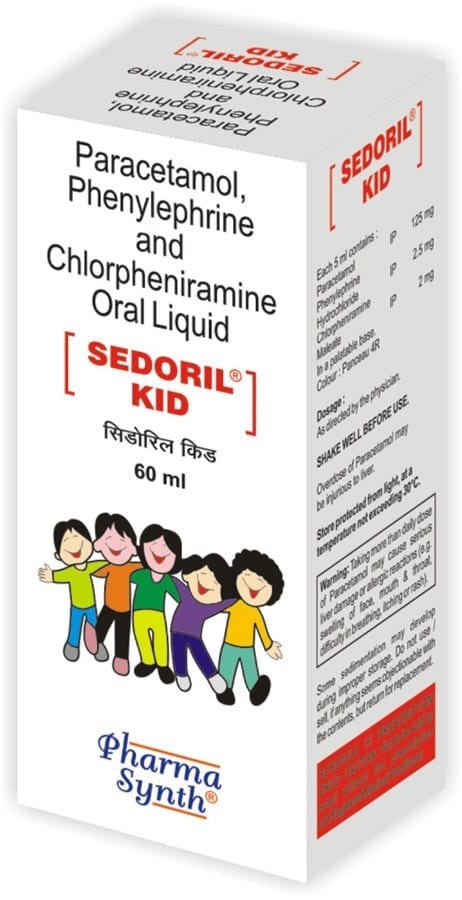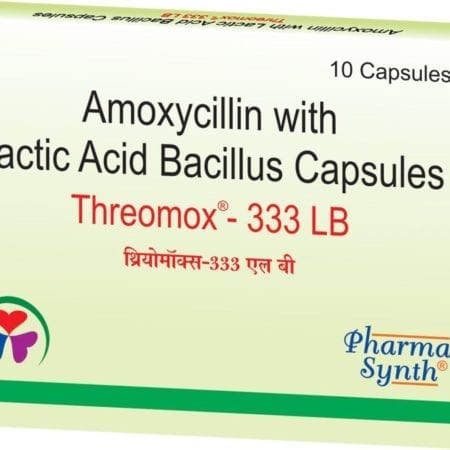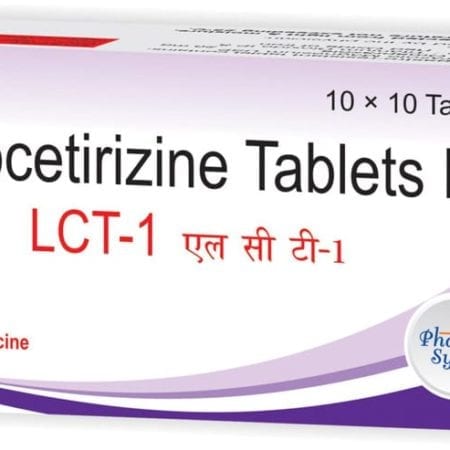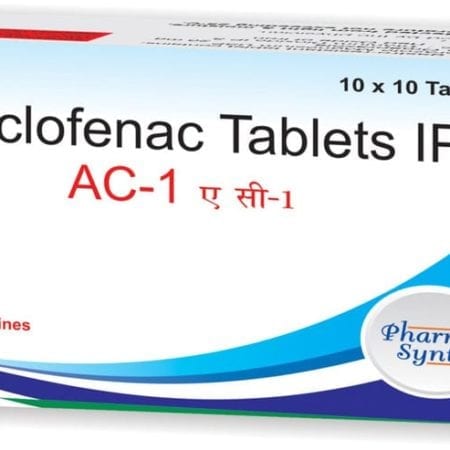SEDORIL Kid
.:: COMPOSITION ::.
Each ml contains :
» Paracetamol IP 125 mg
» Chlorpheniramine Maleate IP 2 mg
» Phenylephrine HCL IP 2.5 mg in a palatable base.
Description
![]()
A cough and cold formula for little ones
Composition:
Each 5ml contains:
Paracetamol IP 125 mg
Chlorpheniramine Maleate IP 2 mg
Phenylephrine HCL IP 2.5 mg
In a palatable base
Dosage form:
Syrup
ATC classification:
Cough and cold preparations
Description:
Sedoril kid formula has clinically proven analgesic-antipyretic Paracetamol with decongestant Phenylephrine and anti histamine Chlorpheniramine to relieve children from symptoms of fever, cold and seasonal allergies. Paracetamol alleviates body pains and fever. Chlorpheniramine maleate treats allergies and hence useful for the cough and cold associated with seasonal allergies. Phenylephrine hydrochloride provides relief from sinus and nasal congestion.
Pharmacological action:
Paracetamol exerts analgesic effect by elevating pain threshold which is thought to be attained by inhibiting nitric oxide pathway mediated by a variety of neurotransmitter receptors including N-methyl-D aspartate (NMDA) and substance P. It shows antipyretic activity by inhibiting the synthesis and release of prostaglandin in the central nervous system, thereby inhibiting prostaglandin-mediated effects on the heat-regulating center in the anterior hypothalamus.
Chlorpheniramine maleate is a histamine antagonist that acts by selectively binding to histamine H1 receptors to block the actions of endogenous histamine. It antagonizes the action of histamine preventing the release of inflammatory mediators or inhibiting the actions of released mediators on their target cells. It also has mild anti cholinergic and sedative effects. Chlorpheniramine maleate exerts its anti histaminic action in the bronchi, capillaries, and some other smooth muscles, and is used to prevent or allay motion sickness, seasonal rhinitis, and allergic dermatitis and to induce somnolence.
Phenylephrine hydrochloride is an oral sympathomimetic amine with selective α1-adrenoceptor agonist action. The sympathomimetic effect of phenylephrine on blood vessels produces vasoconstriction which in turn relieves nasal congestion. It has slightly stronger pressor effect on the venous capacitance vessels when compared to the arteriolar resistance vessels. It treats inflammation of the nasal passages, due to an infection or an allergy. Inflammation associated with allergic rhinitis and rhinosinusitis reduces the physical size of the nasal passages by inducing vasodilatation, increasing blood flow and increasing vascular permeability with inordinate mucus production. Hence vasoconstrictors are used to provide relief from congestion.
Pharmacokinetics:
Paracetamol is absorbed rapidly mainly from the small intestine producing peak plasma levels after 15-20 minutes following oral dosing. Its systemic bioavailability is dose-dependent and ranges from 70 to 90%. Food delays oral absorption. It is rapidly and widely distributed throughout the body with a volume of distribution of approximately 0.9L/kg and is eliminated from plasma with a half life of approximately 2 hours. It is extensively metabolised predominantly in the liver, the major metabolites being the sulphate and glucuronide conjugates which are excreted in urine.
Chlorpheniramine maleate:
Peak plasma concentration of Chlorpheniramine maleate reaches within 2 to 6 hours. Urinary excretion is the major route of elimination. The liver is assumed to be the major site of metabolic transformation and it undergoes enterohepatic recycling.
Phenylephrine hydrochloride:
Phenylephrine is readily absorbed after oral administration but undergoes extensive presystemic metabolism, much of which occurs in the enterocytes, making the systemic bioavailability only about 40%. Following oral administration, peak plasma concentrations are achieved in 1-2 hours. The mean plasma half-life is in the range 2-3 hours. It is extensively metabolized in the liver. Both phenylephrine and its metabolites are excreted in the urine.
Indications:
Sedoril kid is indicated for children to provide
• Provide relief of the symptoms of cold and influenza
• Relief from aches and pains, sore throat, headache, nasal congestion and lowering of temperature
• Relief from clogged nose, runny nose, postnasal drip, itchy and watery eyes, and sneezing associated with the common cold, allergic rhinitis, sinusitis, and other minor respiratory tract infections.
• Also as decongestant of sinus openings and passages.
• As adjunct with antibacterials prescribed for sinusitis, tonsillitis and otitis media
• Post operative after tonsillectomy.
Note: This medicine will not treat an infection. So underlying infection should be determined and treated.
Dosage and Administration:
Dose to be administered based on weight or age. If possible, use weight to dose; otherwise use age
Recommended dosage unless otherwise specified by Physician:
Children 6years age to less than 12 years of age: 1-2 teaspoonful (5-10ml) tid or qid (three times a day or 4 times a day)
Note:
• The above stated dose is to be given only under prescription by the Physician.
• For children below 6yrs of age: Dose is as recommended by the physician
• For children less than or equal to 2yrs of age Sedoril drops is recommended and the respective dosage prescribed by the physician is to be adhered.
Contraindications:
¬ It is contraindicated in patients with hypersensitivity or idiosyncrasy to any of its ingredients.
¬ Sympathomimetic amines (Phenylephrine) are contraindicated in patients with severe hypertension, severe coronary artery disease and patients on monoamine oxidase (MAO) inhibitor therapy.
¬ Antihistamines (Chlorpheniramine maleate) are contraindicated in patients with narrow angle glaucoma, urinary retention, peptic ulcer and during an asthma attack.
Side effects:
Sedoril kid is generally well tolerated.
Stop giving Sedoril-kid and report to your doctor or health care professional as soon as possible if the child complains or you observe any of any of the following adverse reactions:
• Allergic reactions like skin rash, itching or hives, swelling of the face, lips, or tongue
• Breathing problems
• Changes in vision
• Cold, clammy skin
• Dizziness
• Increased heart rate
• Irregular heart beat (arrhythmia)
• High blood pressure
• Hallucinations
• Seizures
• Tremors
• Trouble passing urine or change in the amount of urine
• Fatigue
• Vomiting
Warnings and Precautions:
General:
• This formulation has to be given with caution to patients with Raynaud’s phenomenon or with diabetes mellitus or with severe renal or severe hepatic impairment.
• The hazard of overdose of this medication is greater in patients with non-cirrhotic alcoholic liver disease
• Other paracetamol containing products are not to be taken concomitantly with this formulation.
• A physician has to be consulted in the following situations where the patient has
o high blood pressure
o heart disease
o thyroid disease
o glaucoma
o diabetes mellitus
o chronic bronchitis
o cough that lasts or is chronic such as occurs with asthma
o cough that occurs with too much phlegm (mucus).
• As Sedoril kid contains Chlorpheniramine, caution should be exercised while giving to patients with epilepsy, severe cardiovascular disorders, liver disorders, glaucoma, urinary retention, prostatic enlargement, pyloroduodenal obstruction, asthma, bronchitis, bronchiectasis, thyrotoxicosis and severe hypertension.
• Special care should be taken when using chlorpheniramine maleate in children and the elderly as they are more prone to developing neurological anticholinergic effects.
• In general sympathomimetic amines should be used judiciously and sparingly in patients with hypertension, diabetes, ischemic heart disease, hyperthyroidism, increased intraocular pressure or prostatic hypertrophy.
• Sore throat warning: Consult a doctor promptly if sore throat is severe, persists for more than 2 days, is accompanied or followed by fever, headache, rash, nausea, or vomiting.
• Liver Warning: This product contains paracetamol. Severe liver damage may occur if your child takes:
o More than 6 doses in 24 hours, which is the maximum daily amount.
o With other drugs containing Paracetamol.
• Stop using Sedoril kid and ask a doctor immediately if:
Pain or cough gets worse or lasts more than 5 days.
Fever gets worse or lasts more than 3 days.
Cough comes back or occurs with rash or headache that lasts.
Redness or swelling is present.
New symptoms occur.
These could be signs of a serious condition, please immediately consult your doctor or pharmacist.
Drug Interactions:
¬ The speed of absorption of paracetamol may be increased by metoclopramide or domperidone and absorption reduced by cholestyramine. The anticoagulant effect of warfarin and other coumarins may be enhanced by prolonged regular daily use of paracetamol with increased risk of bleeding; however occasional doses have no significant effect.
¬ Antihistamines may enhance the effects of alcohol, tricyclic antidepressants, barbiturates and other CNS depressants.
¬ Chlorpheniramine and Phenylephrine interact with MAO inhibitors. Hence, Sedoril-kid is contraindicated with MAO inhibitors.
¬ Sympathomimetic amines may reduce the antihypertensive effects of reserpine, veratrum alkaloids, methyldopa and mecamylamines.
¬ Effects of sympathomimetics are increased with MAO inhibitors and beta-adrenergic blockers.
References:
Paracetamol-https://pubchem.ncbi.nlm.nih.gov/compound/acetaminophen#section=Top
Phenylephrine-
https://pubchem.ncbi.nlm.nih.gov/compound/phenylephrine_hydrochloride#section=Top
https://pubchem.ncbi.nlm.nih.gov/compound/8231#section=Top
https://www.ncbi.nlm.nih.gov/pmc/articles/PMC2866558/
Disclaimer:
Information provided above is for reference purpose only and has been compiled for use by healthcare practitioners. Please consult your physician to understand how the product affects you, its dosages, side-effects and further information.
Remember, keep this and all other medicines out of the reach of children, never share your medicines with others, and use this medication only for the indications prescribed by your physician.
Every effort has been made to ensure that the information provided by Pharma Synth Formulations Ltd. (‘PSFL’) is accurate, up-to-date, and complete, but no guarantee is made to that effect. PSFL does not endorse drugs, diagnose patients or recommend therapy and is an informational resource designed to assist licensed healthcare practitioners in caring for their patients and/or to serve consumers viewing this service as a supplement to, and not a substitute for, the expertise, skill, knowledge and judgment of healthcare practitioners. PSFL does not assume any responsibility for any aspect of healthcare administered with the aid of information provided. The information contained herein is not intended to cover all possible uses, directions, precautions, warnings, drug interactions, allergic reactions, or adverse effects. If you have questions about the drugs you are taking, check with your doctor, nurse or pharmacist.




